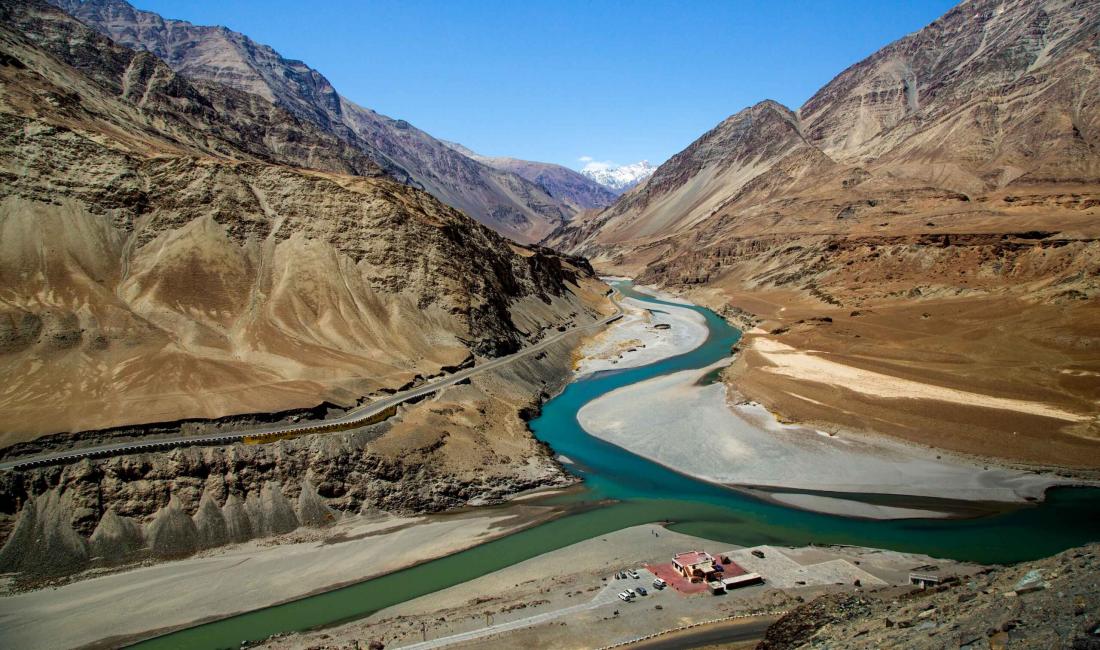In Pakistan's Sindh, Residents Fear the Impact of a Canal Project on the Indus River
This piece is republished here from Asia Democracy Chronicles, which produced it. Photo via ADC by Shutterstock / Rhushikesh Panchal)
Jaffar Hussain has long been struggling to get adequate water supply for his farms in Pakistan’s southeastern province of Sindh. But his water worries have been multiplying since the announcement last year of a plan to construct canals along the Indus River.
For the 42-year-old from Sindh’s Khairpur district, this is a critical moment as his farms are his only way of earning money. The only water he is getting for them at the moment is from the Indus River, and Hussain believes the new canals would pose a serious threat to his livelihood.
“If we cannot have water for our farms, where should we go and ask for help?” he wondered aloud. “Nobody is hearing our voice. We know the canals will be constructed, and our crops will be destroyed, and our lands will be turned into deserts.”
And so while there is planting and harvest to be planned and done, Hussain has been setting aside time to participate in every protest against the canals, and has vowed to continue until the project is canceled.
So far, though, there is no sign that the federal government will do that or even strike a compromise. A decades-old water accord among Pakistan’s provinces has also been rendered useless while bodies supposed to mediate conflicts like this are not really expected to act against plans brought up by the central government.
All these, say environmental experts and Sindh residents, spell disaster for a province of over 50 million people, which produces 42% of the country’s rice, 23% of its cotton, and 31% of its sugarcane.
Sociologist and environmentalist Nasir Ali Panhwar even asserts that the project’s impact is likely to be negative beyond Sindh and would “further jeopardize the future of the Indus Delta.”
Predominantly agricultural, Sindh relies heavily on water from the Indus River for irrigation and other purposes. But the proposed canals will divert water away from the lower riparian province to irrigate barren lands elsewhere, including the Cholistan Desert in the upper riparian Punjab province.
These canals will include the Cholistan Canal and Greater Thal Canal in Punjab, the Raini Canal and Thar Canal in Sindh, the Kachhi Canal in Balochistan, and the Chashma Right Bank Canal in Khyber Pakhtunkhwa. The federal government plans to use these canals to cultivate at least 1.4 million hectares of land for corporate farming, as part of the “Green Pakistan Initiative.”
An unmoved central government
Opposition to the planned canals erupted when the project was announced last August and has continued since. An all-party conference in Karachi rejected the construction of the canals, and protests from various groups are ongoing.
Rights advocate Sharan Kumar Punjwani told Asia Democracy Chronicles (ADC): “Not only the lower and middle-class people will be impacted by the construction of the proposed canals, but its impact will be felt across all the classes in Sindh – including the feudal lords. However, wealthy landowners can mitigate the effects by utilizing alternative water channels, in turn creating an even graver disaster for those people who are heavily reliant on those channels.”
Nisar Ahmed Khuro, president of the Pakistan People’s Party (PPP) Sindh chapter, said: “Sindh can never accept this project of building the six canals. We want to clarify this to the federal government – that Sindh won’t tolerate the act of robbing its right over the Indus River.”
The ruling party in Sindh, PPP is also part of the coalition central government. Yet while opposition to the project has been voiced by various PPP leaders, those who are currently part of the federal government have yet to successfully dissuade Islamabad from pushing through it.
In fact, Planning, Development, and Special Initiatives Minister Ahsan Iqbal has dismissed Sindh’s objections over the proposed canals on the Indus River as “baseless.”
Reacting to Sindh province’s argument that the project would be in violation of the 1991 Water Apportionment Accord (WAA), Iqbal said, “A foolproof, transparent system is in place to ensure its implementation. No province can receive more than its allocated share, nor can any province be deprived of its rightful allocation.”
He pointed out that each of Pakistan’s four provinces has representatives in the Indus River System Authority, which is supposed to regulate and monitor the distribution of water resources from the Indus River.
WAA was established to provide guidelines for water distribution and to address water-related disputes involving the Indus Basin among the four provinces. In situations where there is conflict between the provinces and the federal government, the Council of Common Interests (CCI) steps in to mediate.
Khuhro, however, considers the WAA’s implementation flawed. Various national media outlets have reported the PPP Sindh leader as also questioning why the federal government has yet to call a CCI meeting, arguing that its failure to do so violates the Constitution.
Drowning in water problems
While water issues affect all of Pakistan, Sindh has the most serious water-related problems among the provinces. It faces a severe water shortage, with annual shortfalls ranging from 40% to 45% due to the unequal distribution of water resources. Although this problem recurs every year, the situation became particularly alarming in 2022, when a 60% shortage of water in the Indus River was reported, prompting then Climate Change Minister Sherry Rehman to describe it as “very dangerous.”
Then again, drought conditions in Sindh have persisted since the late 18th century. The most serious drought was in 1999, which lasted till 2002 and affected some 1.4 million people, 5.6 million cattle head, and five million hectares of the cropped area.
The quality of available water in Sindh is also quite poor. Approximately 78% of the region suffers from saline groundwater, which is unsuitable for irrigation, drinking, livestock consumption, and domestic use. Canal water serves as the primary drinking source in Sindh.
Umair Chandio, a teacher at a local school in the province’s Jamshoro District, is among the millions of Sindhis who rely solely on canal water for drinking. The 34-year-old, who also happens to be a farmer, said that the construction of new canals on the Indus River could mean potential starvation for his family and many other people.
“It’s a matter of life and death for us,” he told ADC.
Climate change has exacerbated Sindh’s water crisis as well. Pakistan ranks fifth among the countries most affected by this global issue. In Sindh, erratic weather patterns linked to climate change have only added to the province’s water woes and have led to severe floods during heavy monsoon seasons and droughts during dry periods.
Such fluctuations create water scarcity, affecting agriculture and access to clean drinking water, particularly in densely populated areas that rely on the Indus River for their water supply.
“Sindh is significantly affected by climate change, whether through flooding or drought,” said Sindh-based climate-change expert Naseer Memon. “As glaciers continue to melt, there are growing concerns that water levels will rise and lead to flooding in Sindh, which is primarily flat land. In contrast, the up-country regions, such as Punjab, have a more varied topography that allows water to drain naturally.”
“However,” Memon continued, “the gentle slope of Sindh can trap water, resulting in severe flooding. Therefore, whether due to climate change-induced droughts, heavy monsoon rainfall, or the melting of glaciers, Sindh will suffer the consequences.”
The floods that struck Pakistan in 2022 and caused extensive devastation in Sindh were triggered by climate-related factors. Approximately 2.5 million hectares (18 percent of Sindh’s total area) were inundated, and of that, 1.1 million hectares were cropland. Additionally, much of the crop damage stemmed from extreme rainfall and flash floods.
Overall, around 57% (2.8 million hectares) were affected out of Sindh’s 4.9 million hectares of agricultural land. Hussain’s crops were among those that were destroyed by the floods, as Khairpur was one of the worst affected areas. “It was like hell unleashed upon us,” he remarked.
Decrepit irrigation system
The floods also severely damaged Sindh’s irrigation system. More than 538 irrigation systems and 234 drainage systems, totaling an estimated 7,300 kilometers of canals, were destroyed.
Hussain’s fields are now barren, as the floods washed away most of the irrigation infrastructure, leaving no water for his crops. And yet, said teacher-cum-farmer Chandio, federal authorities are willing to spend PKR 211 billion (US$757 million) on one of the canals alone: the Cholistan.
“This much money could have been spent on repairing the already damaged irrigation system of Sindh and for improving our lives,” Chandio said. “The Cholistan canal will ruin us.”
Even without the damage wrought by severe weather disturbances, Sindh’s irrigation system was already experiencing chronic structural challenges that had been significantly contributing to the province’s water crisis. Much of the infrastructure is outdated and, in many areas, in poor condition. A notable event occurred in June 2024 when two gates of the Sukkur Barrage collapsed, underscoring the long-standing neglect of this critical system.
Sindh has two other major barrages: Guddu and Kotri. But the Sukkur Barrage is particularly important, as it supplies irrigation water to approximately 3.32 million hectares of land in Sindh, or about 75% of that devoted to agriculture in the province.
Kotri Barrage is also experiencing structural issues. In 2023, a sinkhole emerged near the barrage, posing a threat to its stability. Other irrigation channels and distributaries suffer from the same problems.
“The irrigation infrastructure of Sindh is not in a good state,” noted Memon. “Sukkur Barrage’s gates fell because of years-long neglect and poor maintenance. There is no proper desilting of distributaries, and breaches are reported quite frequently.”
Another contributing factor to Sindh’s water issues is the lack of an efficient water-management system. Said Memon: “Sindh’s water distribution faces significant challenges. The irrigation management in the province is plagued by corruption and inefficiencies. As a result, small farmers, who lack political influence and reach, bear the brunt of these issues.”
Chandio could not agree more. “We need our irrigation system problems resolved so we can worry less,” he said. “Our canals and barrages require proper maintenance. I am reiterating that rather than building new canals, first they (the government) should repair the already damaged irrigation system in the province.”



